site-specific interventions
(most recent first)

A few works are 'autonomous', meaning they were made to be shown in any space.
an intervention 'in Relation' can only really happen 'in a place'...
There is no generalized strategy of action in Relation that can be developed...
These attempts at repossession or global action run up against the singularities
of Relation every time. Relation is only universal through the absolute and
specific quantity of its particularities.
Édouard Glissant
A performance as BLACCXN PR guru 6
Whitechapel Gallery as part of
Whitechapel Art Book Fair (2009)
corporate sponsorship

Anobium Punctatum (Woodworm) : an intervention (2019)
This project and art intervention into the Yorkshire Sculpture International was proposed by Alana Jelinek, at the invitation of Rececca Wade, Assistant Curator for Sculpture at the Henry Moore Institute.
The exhibition was the product of workshops with various groups working with the ethnographic collection of World Cultures at the Discovery Centre. The objects in the installation were made by participants and also chosen by them from the World Cultures collection.
The names of the participants are John Hornsby, Adrian McCluskey, Sarah Glatherine, Leigh Newton, Esther K. Niangi, Elisabeth Ndonga, Samer Altamah, Zaynab Doli, Fatin Najem, Nokhsha Ahmed, Kinaa Baraka, Amina Sutaife, Nawzad Mahmood, David Blakeley, Fe Uhuru, Nelson Rodriguez, Igor Pedraza, Katy Pedraza, Peter McDonagh, Colin Barden, Maryam Shokrizadeh, Olive Sanderson, Teagan Riches, Michael Ferens and Rebecca Wade.
These makers of art, Art, folk-art, community art, craft, experiment or ethnography have been facilitated by others, including translators (Fadwa Az-Jaleli, Shaimaa Khattab), collections, education and outreach experts and curators (Jasmine Evans, Clare Jolley Judith Shalkowski, Alison Smith, Megan Jones, Angie Thompson).
There are, no doubt, many others who laboured invisibly to enable the artwork to happen.
Although integral to the final piece, all the work by these named and unnamed people is rendered invisible under the artist's name and the title of the work. This is always the way with Art. It is a necessary condition for art to be Art and not something else. The invisibility of most, the anonymity of some, is required.


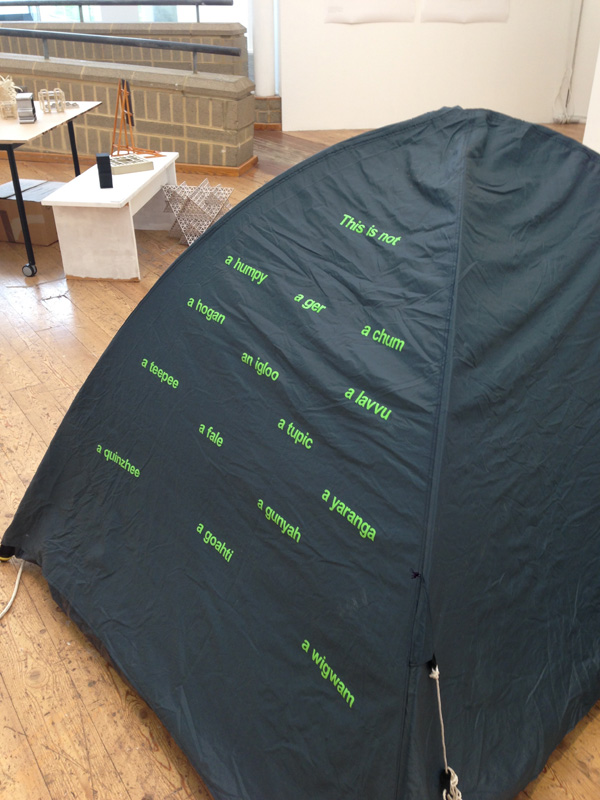
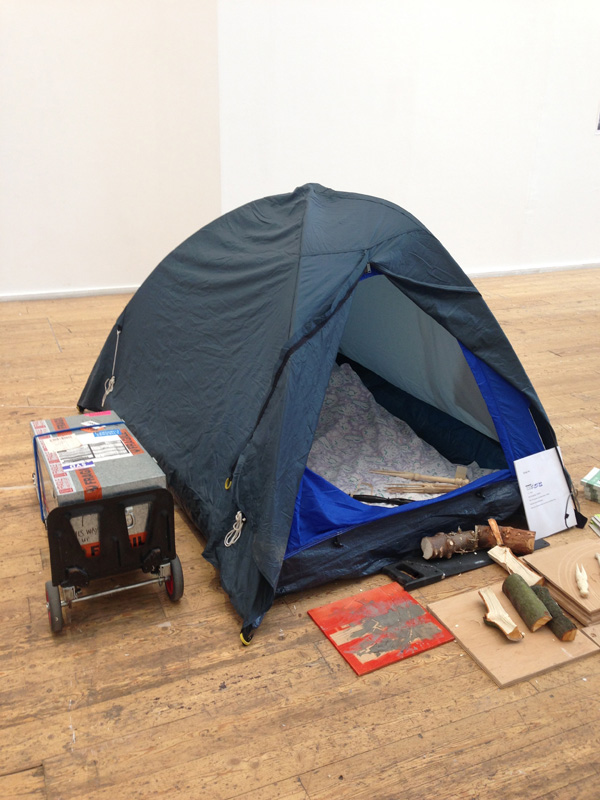
The White Possessive (2018)
An intervention into the School of Creative Arts, University of Hertfordshire, for the 'In Process' exhibition, curated by Sam Jury and myself on behalf of the Contemporary Art Practice research group.
The intervention consisted of a re-purposed 2-person tent with vinyl lettering stating on the back what the tent is not:
a humpy, a ger, a chum, a hogan, an igloo, a lavuu, a teepee, a fale, a yaranga, a gunyah, a quinzhee, a goahti, a wigwam .
The tent's flaps were open and contained a comfortable place for sitting with a tablet computer playing Tall Stories: Cannibal Forks
There were also the tools and detritus of cannibal fork making, as well as two other previous artworks on a similar theme, namely the novel,
'Ohm's Law' (2007) and the slide puzzle, 'Trickle Down +' (2005). Both were available to keep, a gift for anyone who wanted them.
The title was inspired by, taken from, Aileen Moreton-Robinson's The White Possessive: Property, Power and Indigenous Sovereignty (Minnesota University Press 2015)
Universities today compete in a global market for student debt. Each university attempts to lure students from all over the world, including increasingly from China, to pay the offensively expensive overseas student fees in order to balance the domestic books. As a consequence of its wide student intake, and the fact that universities are meant to be bastions of liberal plural democratic western values, it is incumbent on each lecturer and researcher to address our own internalised racism and sexism.
For those who find this political correctness gone mad, let me assure you, universities continue to be (in the main) playgrounds of class, race and sex/gender bias. Implicit and entrenched systems of hierarchy lie undisturbed, as universities' own statistics on the gender pay gap, Black and Minority Ethnic ('BAME') attainment gaps and the lack of women at the higher levels of research and management attest.
Intervention
A mini-retrospective of artworks that have dealt with the question of ongoing colonial relationships between Europe, the West, and the rest, contained in a tent.
While tents may recall, for some, Tracey Emin's 'Everyone I ever Slept With 1963-1995' (1995) and evoke music festivals, for me they are quintessential symbols of the primitivist urge within western culture to 'get back to nature': the idea of imagining a self-sufficient past based on myths of what it is to be a 'hunter-gatherer', the primitive. Tents are a white and gendered cultural appropriation, dressed up to seem like something less offensive.
Personally, I like camping. It's my tent. However I also know how 'adventure tourism' is marketed and sold, that the Nazism and naturism were utterly compatible in the 'Blood and Soil' myth. I am also aware of which demographic groups today are particularly keen on the idea of self-sufficiency and 'survival skills', both of which I regard as versions of a primitivist fantasy and an actual appropriation of land, skills, knowledge and resources.
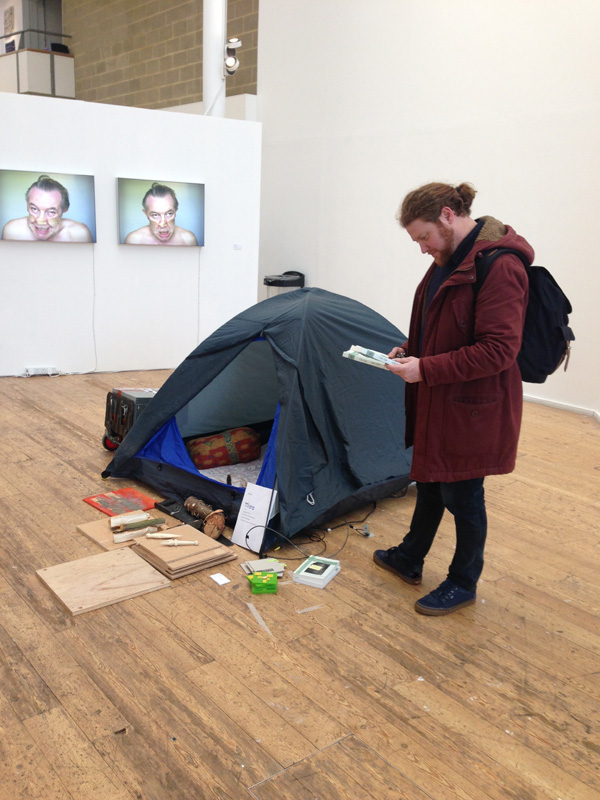

Both a site-specific intervention into the Museum of Archaeology & Anthropology, University of Cambridge, and a stand-alone artwork, The Fork's Tale, as narrated by Itself is the story of the relationship between collections, collectors and the collected written from the point of view of a nineteenth century Fijian cannibal fork adn forms the final artwork of the Arts & Humanities Research Council funded fellowship.
An artist's book serialised over 12 months published in chapters each month, beginning the 15th January and ending the 15th December 2013, echoing a nineteenth century paradigm in publishing by authors such as Charles Dickens and Wilkie Collins. Published by LemonMelon, The Fork's Tale, as Narrated by Itself became a collection by a fictive collector, including collector's notes on 15 January 2014.
Chapters include drawings by the 'cannibal fork'.


The cannibal forks in the Museum's collection are the oldest in the world. Nevertheless they are highly contested artefacts. On the one hand they are understood to be material proof of past savagery, on the other, many are known to have been made specifically for an early tourist trade in native curios and have never touched flesh, let alone human flesh.
In the context of the University of Cambridge, knowledge, truth, big ideas are understood as properly the realm of science, philosophy and history. The role of art is not to produce knowledge, as such, but to describe emotions as an act of self-expression or a moment of beauty.
Intervention
'The Fork's Tale, as narrated by Itself', written from the point of view of a nineteenth century Fijian 'cannibal fork' in the collection of the Museum of Archaeology & Anthropology, is an artwork and novelistic exploration of the idea of fact and facticity. At its most basic reading, the novel is an exploration of the various historical facts surrounding these highly contested objects and the passionately contested histories of cannibalism in the south Pacific.
Were they ever used in cannibal feasting or are the forks an everyday object to which gruesome narratives of the horror of cannibalism were attached through contact with Europeans fascinated by these stories? Or were the 'cannibal forks' simply manufactured by both entrepreneurial Fijian and European beachcombers wanting to capitalize on the emergent tourist market by creating tourist curios? Indeed, was cannibalism (anthropophagy) ever even performed in Fiji or are tales of cannibal feasting the product of a racist colonial imaginary?
Overlaid on this historical, political and ideological contestation of fact is the types of fact that are the focus of other disciplinary analysis. For example, the fork experiences the difficulty in knowing from experience, empirically, phenomenologically, through sensation and senses. When is experience a fact? When does empirical and phenomenological experience create 'facts'? The fork reflects on the difficulty in knowing or experiencing 'facts' (reality?) when also experiencing psychological facts, such as longing. Written and published one month at a time for 12 months throughout 2013, The Fork's Tale also explores the fact of time passing, the occurrence of exogenous events and how this effects internal knowledge and meaning-making.
This intervention in the context of University of Cambridge is the assertion that art is a knowledge-forming discipline that can productively bring together and add to the knowledges created by history, philosophy, politics, anthropology (etc).
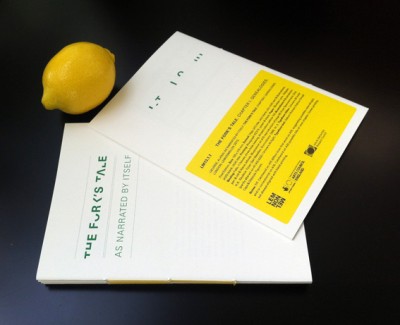

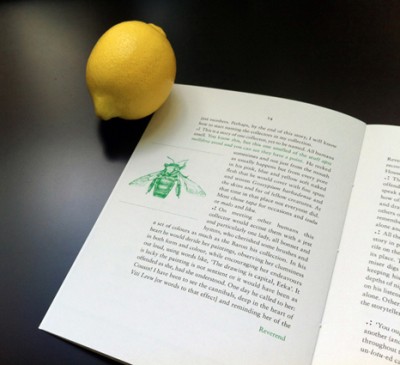
images ©LemonMelon
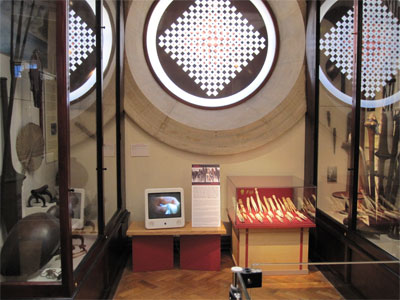
In 2010, ‘Tall Stories: Cannibal Forks’ was shown as a site-specific intervention into the then current displays of Fijian artefacts at Museum of Archaeology & Anthropology, University of Cambridge. It was later displayed as an 'autonomous' artwork, part of the Gifts and Discoveries exhibition in 2012.
Panel Text

Part of a research fellowship funded by the Arts & Humanities Research Council with the Museum of Archaeology & Anthropology, University of Cambridge, investigating the relationship between collections, collectors and the collected.
Tall Stories : Cannibal Forks was an attempt to collapse the categories of collections, collectors and the collected, so that collectors became the collected as part of the museum's collection.
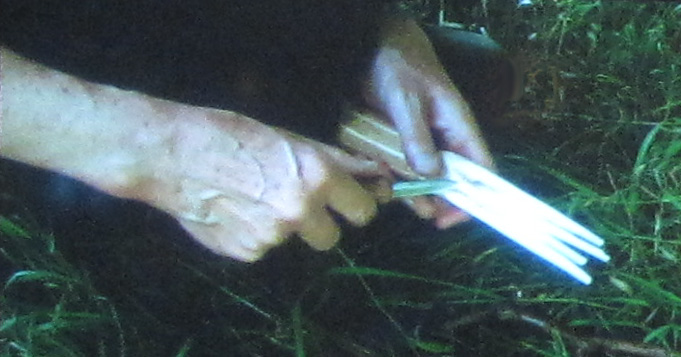
I sought out more information because they didn't make sense to me as a shape. Most seemed unlikely or impossible as functional forks, especially the type of fork that goes into the mouth.
I was told a range of stories from hair-raising missionary tales of Fijian sadism and barbarity to an idea current in anthropological circles that few if any of these were made for the purposes of cannibal feasting. Many, perhaps all, were made in response to 19th century tourists like misionaries and early ethnologists.

15 September 2010 - October 31 2010
The original instantiation of the artwork is an 8min video shown on an old imac of a group of people's hands carving a cannibal fork from tree branch to decorated object accompanied by an audio track of the various knowledges and stories held by staff from the Museum and the newly crafted cannibal forks.

These were shown next to the display of Fijian artefacts including 3 'cannibal forks' labeled simply as
Cannibal Forks
used by High Chiefs and Priests
19C Fiji

Colleagues from across the museum were invited to participate in creating their own cannibal fork, including front of house staff, technicians, curators, research assistants, educators. Cannibal forks were carved using traditional European green wood working skills and using native woods (lime, sycamore). These new cannibal forks were later accessioned as part of the museum's permanent collection.

Performed on 12 November 2012 by an invited group of artists, archaeologists, art educators, philosophers in order to interrogate the idea of Greek pottery as art and the idea of Greek artefacts as the pinnacle or origins of artistic practices as we understand them today.

Part of a research fellowship funded by the Arts & Humanities Research Council with the Museum of Archaeology & Anthropology, University of Cambridge, investigating the relationship between collections, collectors and the collected.
Staged at the Fitzwilliam Museum, University of Cambridge, and boasting a neo-Classical facade and homage to the Parthenon freize, the museum's classical collection contains artefacts, including ancient Greek pottery. Like much of Cambridge University until recently, the Fitzwilliam Museum embodied and perpetuated the idea that classical Greece and Rome were the pinnacle of Civilisation, producing High Culture and the origins of High Art.

Not Praising, Burying :
The Rules
1. Everyday, throw-away, low-value vessels must first be prepared with a ground (surface primer) the colour of clay.
2. Low-value, throw-away vessels painted to appear like clay must then be decorated using the colours used by ancient Greek potters.
3. Painted decorative elements of the vessels must be in the style of ancient Greek red-figure or black-figure ceramics.
4. Representational elements must be translated into contemporary terms.
The Premises
1. That the ideas presented by Vickers and Gill in Artful Crafts (1994) are largely correct, and specifically:
b. ceramicists were a low-status group and not artists in any contemporary understanding of the term,
c. ancient Greek red-figure and black-figure pots were skeuomorphs
of metallic objects.
black = oxidised silver
red = gold
deep red = bronze
white = ivory
2. That equivalents exist in contemporary (Western) cultures of most instances of (existing) ancient Greek material culture. There is a significant difference between a translation and an equivalent.
Neoclassicism is one type of translation, as is any diasporic or anachronistic reference to the styles associated with classical Greece.
3. That ancient Greek ceramics depict three types of contemporary subject. There is a significant difference between a contemporary understanding of Classical cultures and a then- contemporary understanding of a lived culture.
12 November 2012
participants / interpreters of rules
Anna Bagnoli (sociologist)
Juliette Brown (co-founder terra incognita)
Sarah Campbell (Kettle’s Yard)
Elena Cologni (artist)
David Cross (artist)
David Gill (archaeologist)
Sudeshna Guha (archaeologist)
Charles Hustwick (artist)
Alana Jelinek (artist & rule setter)
Derek Matravers (philosopher)
Christos Tsirogiannis (archaeologist)

©Khadija Carroll
Participants are invited to carve their own cannibal fork using traditional skills and English native woods in a self-conscious act of repetition: repeating the act of creating the myths and objects that embody the myths surrounding so-called cannibal forks.
Participants are encouraged to pass on the skills and knowledge required to make further cannibal forks. They are also encouraged to contribute to the Museum's collection of 'cannibal forks'. Many participants donated their cannibal forks to the Museum of Archaeology and Anthropology, University of Cambridge. They have been accessioned.
First experiment in distributed protocol, 'Cannibal Forking', occurred on 25 September 2010 at 'The Field'.
Then at the following venues:
Chinese University Hong Kong, 12 November 2010
Museum of Archaeology & Anthropology, University of Cambridge, 29 October 2011
The Project Space, London 'again : on repetition an informal symposium on repetition in practice', 28 November 2011
Bodger's Ball 2012, nr Axminster, Devon, 12 May 2012
*NB The making of cannibal forks may or may not predispose a participant towards cannibalism.

The concept of a distributed protocol is borrowed from the internet. My understanding is that a distributed protocol is a method of networking and distributing information. This interpretation could be wrong but I was playing with the idea of distributed (dis)information and networks.
Intervention
cannibal forking : an experiment in distributed protocol was an intervention into the idea that people not marked as 'ethnic' or 'indigenous' (that is, white middle class Europeans) could make artefacts collected by a museum devoted to collecting authentic indigenous artefacts.

cannibal forking at The Field 2010
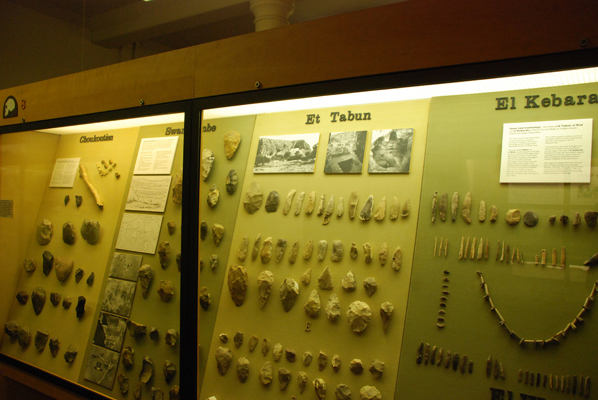
23 October 2009 - March 2010
Museum of Archaeology & Anthropology, University of Cambridge
One of the real world incarnations of the BLACCXN project.
BLACCXN had the opportunity of sponsoring the archaeology gallery before it was updated in 2013. The BLACCXN intervention highlighted the racist subtext behind the 30 year old archaeology display and linked it with neo-liberalism.
The Private View happened on Thursday 22 October 2009. Timed to intervene into The Cambridge Festival of Ideas and Darwin's 200 year anniversary celebrations, it included a presentation by the BLACCXN PR guru.

Part of a research fellowship funded by the Arts & Humanities Research Council with the Museum of Archaeology & Anthropology, University of Cambridge, investigating the relationship between collections, collectors and the collected, The Archaeological Story according to BLACCXN was the first in a series of 5 artworks that were the product of the research fellowship. The Archaeological Story according to BLACCXN aimed at investigating a relationship between sponsorship, museums display and interpretation.
Until 2010, the Clarke Hall occupied the entire ground floor of Museum of Archaeology & Anthropology, University of Cambridge and was devoted to archaeology. The 30 year old display told an already philosophically and archaeologically out-dated story of human evolution and progress, celebrating a particularly insidious version of human evolutionary theory. Starting with pre-human hominids, it took the visitor on a journey from the paleolithic and neolithic, through to the bronze age, iron age and Romans, culminating in 18th century Cambridge as the pinnacle of evolution. Contemporary cultures were slotted into the 'story of human evolution' so that, for example, contemporary Australian Aboriginal people and their artefacts were elided with the paleolithic era as 'primitive survivals'.
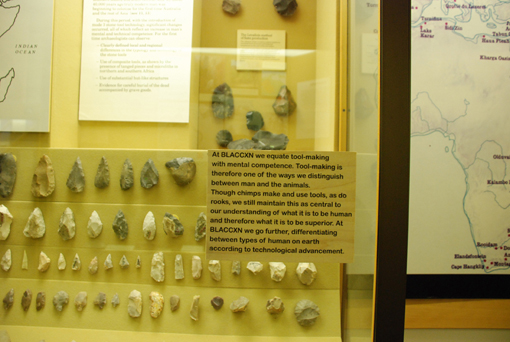
For this intervention, a new series of interpretative text labels were added to the existing display. Nothing was altered in the existing display.
The labels were made of box ply wood in order to blend into the aesthetics of the display.
The entire series of BLACCXN labels can be seen as a wordpress blog so that feedback could be recorded.
A comments book was also available for the duration of the intervention. It was well used.
It is important to note that although this intervention proved very controversial with both the public and the archaeology department (at least one archaeologist walked out of the private view), I was free to make the kind of work I felt the opportunity demanded.
I have experienced an amount of censorship in my career but my mentor and boss, Prof Nicholas Thomas, maintained my right to artistic and academic freedom throughout the fellowship.
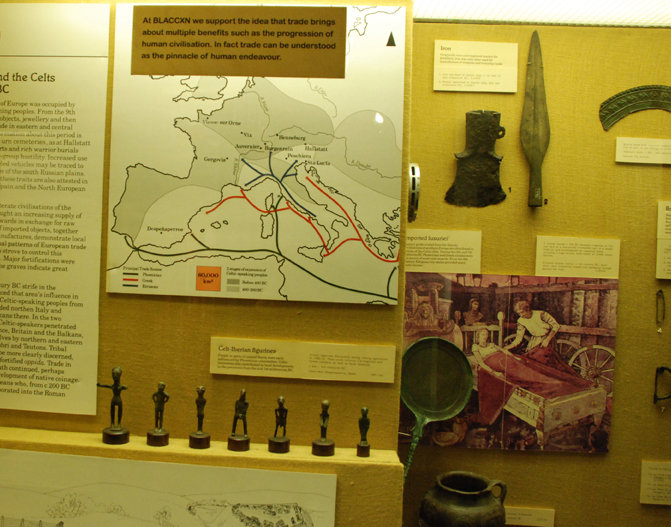

Priory Meadow Shopping Centre, Hastings
'Points of View' Hastings Museum and Art Gallery curated by Maud Belleguic and Judith Stewart
Originally a museum-based exhibition, I decided to take 'europe the game' with all its particular political resonances in the local setting to the main shopping centre.
This is not something I will ever repeat. Although there was some engagement in the artwork with those in the shopping centre, it was a great struggle for art, even interactive art, to compete with the shopping experience.
54factorial permutations of Europe with 54/36factorial exclusions at any one time.
An interactive, participatory oil painting
54 birds eye view landscape paintings can fit into a frame that includes a maximum of 36 paintings.
Each painting is 60x60cm.
Rules for engagement:
1.each player must take it in turns to choose which of the 54 paintings fit 'Europe'
2.the frame 'Europe' can contain a maximum of 36 paintings
3.when Europe is full, players must take it in turns to alter any choices
more images of europe the game in other locations
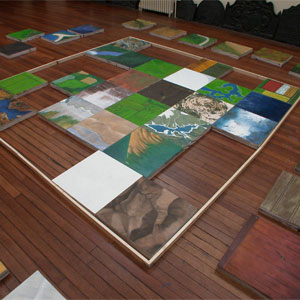
© Hastings Museum and Art Gallery
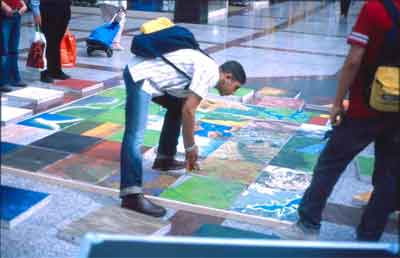
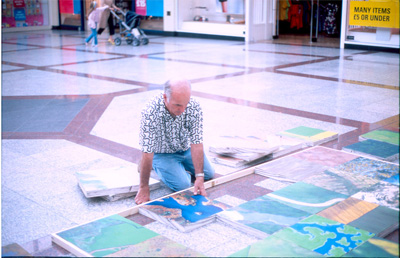
On 1st May 2009, Mayday, 6 birds eye view oil paintings of various locations of capital growth were placed in 6 physical locations that have seen an increase in the growth of privatisation or corporate sponsorship.
- Neoliberalism, or the ideology of market meritocracy
- Privatisation, or replacing public sector providers of services and public goods with profit-making companies
- Mixed-economy, or privatisation where public funding, especially for the arts, is part replaced by sponsorship and profit-orientated enterprises
London Stock Exchange was taken to Tate Modern (boardroom) and left for art lovers, passers-by or the police.
London Metals Exchange was taken to the Ministry of Defence (trading floor) where filming took place by someone who apparently worked there. Like all other paintings in the Mayday intervention, it was left for art lovers, passers-by or the MoD.
Lloyds of London was taken to the Science Museum, London (original interior or public area).
London Stock Exchange was taken to Canary Wharf, the main centre of London banking outside The City of London (computer hub)
BLACCXN was taken to the site for the London 2012 Olympics (boardroom)
London Stock Exchange was taken to the Unilever Centre for Molecular Science Informatics Building, University of Cambridge (public foyer)
All parts of the paintings, which were in 60 x 60cm parts, were signed on the back with my name and a contact email so it would not be misconstrued as an anonymous act.
Link to more images
Photographer for all site-specific images ©Kristian Buus
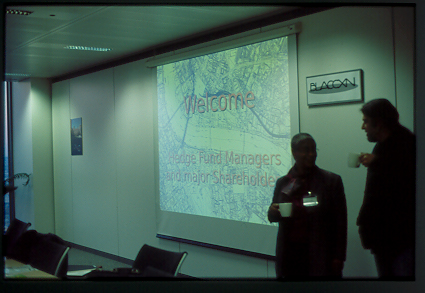
performance as BLACCXN PR guru6, Citigroup Tower, Canary Wharf, London
*as with most of my performances, there is no recording because the emphasis of my work is on the experience and interaction of participants and not the documentation. It was photographed and also reviewed by Jack Hutchinson for AN

more about the BLACCXN
project
BLACCXN AGM described by
Jack Hutchinson for AN


Jim Thompson House, Bangkok, Thailand
'Interweaving Cultures' curated by Gridthiya Gaweewong (Th), Sachiko Namba (Jp), Ann Coxon (GB)
More images of Detail
Jim Thompson House, a museum dedicated to preserving and displaying the authentic in Thai culture, was the home of the US silk entrepreneur, Jim Thompson who disappeared in myserious circumstances in 1967.
The museum is now filled with Thai antiques and is itself an amalgam of 6 traditional Thai teak-built houses situated in the middle of contemporary modernist Bangkok.
Across the river is a small community of silk weavers who used to produce silk for the Jim Thompson silk company. The Ban Krua are Muslim, a religion that is sometimes portrayed as not authentically Thai.
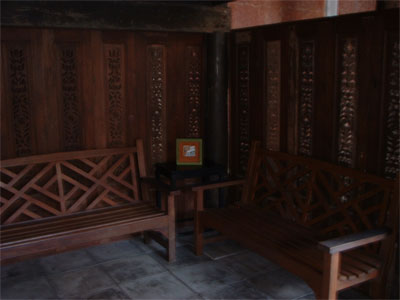
24 small paintings on the back of canvases, measuring 20 x 20cm2, stretched with Jim Thompson™ silk were displayed throughout the museum as a site-specific intervention into steroetypical notions of authenticity as promoted by the museum.
Each of the 24 paintings were from photographs taken by members of the Ban Krua community of aspects of their daily life. These included local parks, mops, buckets, shoes in racks outside people's homes, and the local Madrassa.
After exhibition, the intention was to give the people who had taken the photos the paintings.
After 6 weeks on exhibition, the intervention was censored and paintings were moved to the 'neutral' space of the adjacent gallery. No documentation was allowed to be seen or refered to again in any future press. It was as if the original intervention never existed.
More images of Detail


Jim Thompson House Gallery, Bangkok, Thailand
'Interweaving Cultures' curated by Gridthiya Gaweewong (Th), Sachiko Namba (Jp), Ann Coxon (GB)
Before making artwork for 'Interweaving Cultures', the artists who were not from a Thai background were invited to visit Bangkok, the Jim Thompson House and Museum, and the silk factory on a research trip. On the basis of this research trip, I came to understand 'trickle down' economics in a new light. It was abundantly clear that foreign currency wealth, including both aid and investment, did not touch the majority of local people, who live in a completely different economy.
Intervention
Trickle Down + is a game, based on shuffle puzzles. At first glance all the pieces appear to move around the board with freedom and ease. On playing the game it becomes apparent that some of the pieces, those with non-Thai global currency symbols, only flow in a few directions and some don't move at all.
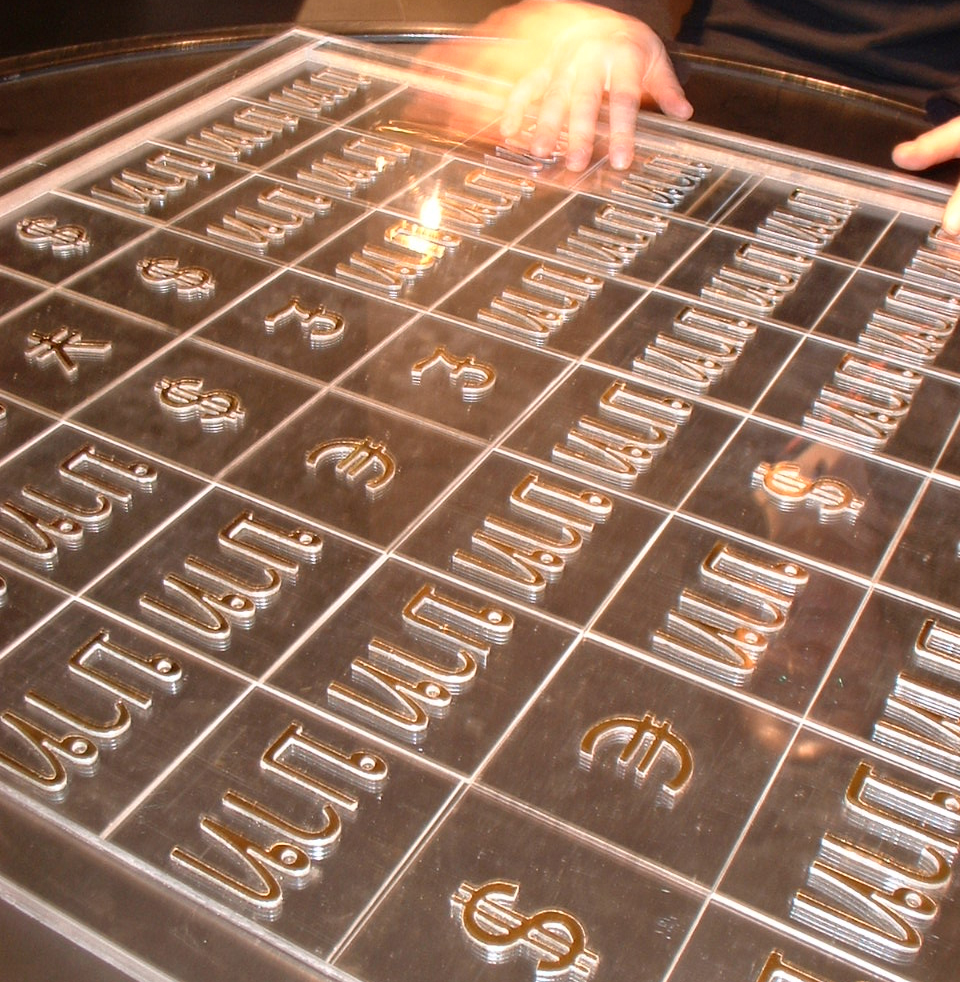
A smaller portable version, an 'autonomous' art object, was also produced for the exhibition and was given away during its run.
It was later given away with copies of Ohm's Law (2007), the novel written in response to this experience of globalisation, global capitalism and trickle down failure.
Ohm's Law published by terra incognita

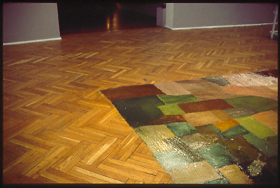
Fields of Vision, Arsenal Gallery, Poznan, Poland
Dry pigments on floor of gallery
Birds eye view of English and Polish landscapes melting into each other
